|
 |
|
| Part 1 Preparation, Fukuoka Airport to Beppu Spa |
| Part 2 Yufuin, Takachiho Gorge, Aso Kusasenri |
| Part 3 Yanagawa, Oura Church, Glover Garden |
| Part 4 Dazaifu Shrine, This and That |
|
|
|
Part 2
Yufuin, Takachiho Gorge, Aso Kusasenri |
|
|
December 24th, the 2nd day of the trip.
Contrary to the weather forecast since one week ago, we are now blessed
with a fair sky. We left the city hotel in Beppu Spa at 7:45.
The fog became thicker and thicker as our bus was running, and in one hour
when Yufuin Town was near, the very thick fog was going to cover the whole
area.
|
|
| Kinrinko Lake at Yufuin Town
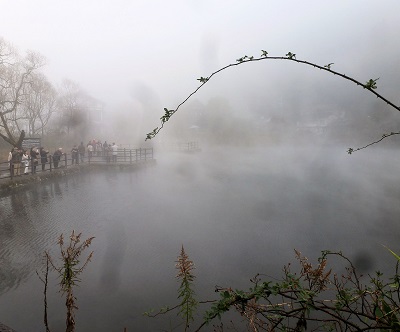
| Both hot springs and cold springs are gushing out from the bottom of the
lake. Therefore the water temperature is warm even in winter and a fantastic
landscape covered by a fog can be seen early mornings of a cold day. (JTB
Publishing) |
Just as pointed out, Yufuin is the town of fog. How far can we see? It
is really the world of fantasy!
We walk along Kinrinko Lake for a while, in an imagination for the invisible
view. It is not cold.
Yufuin Town forms a typical green basin surrounded by Mount Yufu.
The present scenery may be particular to this season, and knowing it, we
had a free walk for one hour, immersed in the grace.
In the bus leaving Kinrinko Lake, the talk of the lady guide F about Mount
Yufu was interesting to me.
Priest Saigyo wrote a waka poem of Mount Yufu (Yufu-dake) in late Heian
Period (around 12th century).
The top of Yufu-dake in Toyokuni area is like Mt. Fuji, with no cloud nor
haze.
(Toyokuni no Yufu no takane ha Fuji ni nite kumo mo kasumi mo wakanu narikeri)
Then, Mount Yufu got so angry that it erupted with a pillar of fire and
threw up black smoke to the sky, scattering red stones on all sides.
Saigyo was surprised and corrected the waka as follows.
The top of Mt. Fuji in Suruga area is like Yufu-dake, with no cloud nor
haze.
(Suruga naru Fuji no takane ha Yufu ni nite kumo mo kasumi mo wakanu narikeri)
After that the eruption died down at last. |
I am a Matsuo Basho fan, a famous haiku poet in Edo Period, and Basho admires
Priest Saigyo.
In his travelogue "The Narrow Road to Oku" (in the late 17th
century), after a long stay at Nasu-Kurobane (Tochigi Prefecture) for 14
days, Basho headed for the Deep North.
Before passing through Shirakawa Checkpoint, he visited the willow trees
commonly called "Yugyo Yanagi" where Saigyo created the following
waka poem contained in the famous waka book "Shin Kokin Waka Shu".
Michinobe ni shimizu nagaruru yanagikage
shibashi totekoso tachitomari tsure. |
While traveling, I found a clear stream
and a shade of willow trees.
I wanted to take a rest there,
and felt too good to leave.
(translated by myself) |
The following haiku poem was written there by Basho, adoring Saigyo.
ta ichimai
uete tachisaru
yanagi kana |
They sowed a whole field,
And only then did I leave
Saigyo's willow tree
(translated by
Donald Keene) |
But even so, isn't it surprising that Priest Saigyo, in the period of late
Heian and early Kamakura Period (in the 12th century), appeared around
the Deep North (Northern Japan) and left his footprint in Kyushu!
|
|
|
Takachiho Gorge
Our bus drove south from Kinrinko Lake to Takachiho Gorge for 3 hours.
We walked along the esplanade of the gorge nearly 1 hour from just before
2:00 p.m. and saw the sights since the age of the gods.
Takachiho is situated in the deep mountains north of Miyazaki Prefecture.
There are various places associated with mythology like Amano-kaguyama,
Takamagahara and Amano-Iwato. Especially Amano-Iwato is the most famous
myth as "The cave of the sun goddess" in the Kojiki and Nihon-shoki
(Records of Ancient Matters).
The story is:
Furious at violence acted by her brother Susano-o, the god of storms, the sun goddess Amaterasu hid in a rock cave, plunging heaven and earth into darkness and bringing on a series of disasters.
A convocation of other deities worked out a way to make her open and exit
the cave, returning brightness and peace to the heavens. In order to get
Amaterasu out of the cave the other gods threw a party outside. The goddess
Ame-no-Uzume-no-Mikoto performed a lewd dance, eliciting much laughter.
Amaterasu grew curious about the source of such mirth and peeked out of
the cave entrance. She became fascinated by her own reflection in the Yata
no Kagami mirror which the other gods had crafted and hung before the cave
for that purpose, and stood transfixed. Ame-no-tajikarao then forced the
cave open and the world was bathed in light once again. As Amaterasu stepped
out of the cave a holy seal was applied to it so that she could never go
back into hiding. (Wikipedia) |
F guide emphasizes,
"Full of myths and legends, Takachiho Gorge has been known since ancient
times as a sacred ground where the gods descended to earth. The area is
also famous for yokagura, sacred dance rituals, reenacting the legends,
which are performed in the fall and early winter.
The sheer gorge running through a basin surrounded by steep green mountains is the highlight of a magnificently variegated terrain that presents fresh beauties with the changing seasons." |
There are a lot of other myths like "Birth of the Island and Purification
Ceremony" and "Descent from Heaven", but I am not good at
them.
-----
Incidentally, When we visited this spot in September 2000, 15 years ago,
it was raining hard. I remember Emiko was holding an umbrella. This picture
is the evidence.

It was a 5-day tour that time, and besides Takachiho Gorge, we visited
several famous places like Aso, Beppu, Aoshima, Udo Shrine, Sakurajima,
Ibusuki, Chiran, Unzen and Nagasaki.
I left only the photo album in the "Someday, Somewhere" square
of this homepage as I had no idea of making a travelogue then.
I tried to add some explanations in English to the album in an attempt
to introduce them to overseas people, but in vain. My memory was too vague.
That's why I decided to join this tour, thinking it would be useful even
if it is a part of the whole Kyushu.
-----
We are enjoying fine weather this time That's why or not, I am amazed by
the splendid landscape. However, the divine atmosphere handed down since
the age of the gods have passed by my body.
Nevertheless, we are here at Takachiho Gorge with the cliff of 80 to 100
meters continuing for 7 km. It is not superficial.
I would like to introduce a couple of views impressed me.
The Esplanade and the 3 Takachiho Bridges
The esplanade along the gorge had a good maintenance and so we enjoyed
a comfortable walking.
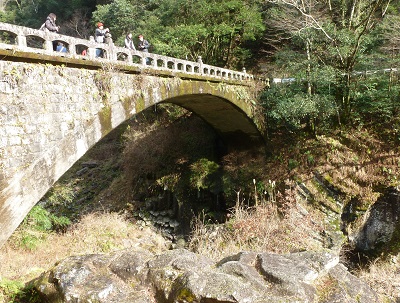
Soon on the way, we arrived at the place with a whole view of the three
arch bridges of different taste. This point is said to be the only place
around the gorge possible to see the three arch bridges at the same time
in Japan. I am confident that I took a nice shot, blessed by the fine weather.
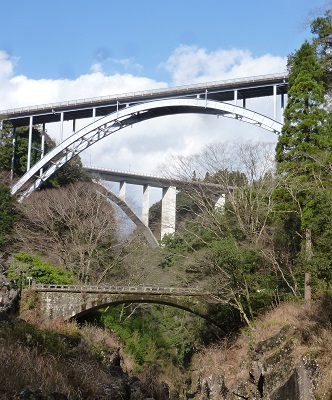
Manai Falls
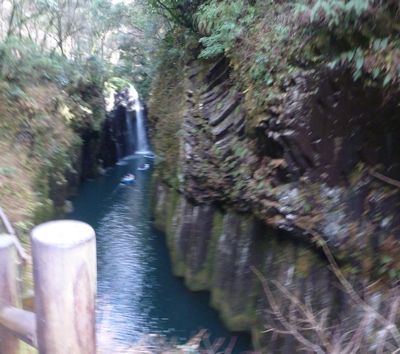
This falls is running down about 17 meters at the narrow point of Takachiho Gorge, which is among "The 100 Falls in Japan".

Young people on the several boats look enjoying floating just under the
falls, though it seems so cold there.
 That reminds me, I swam in the splashing basin of the Nachi Falls, 133
meters down from the top, which is near my hometown. That reminds me, I swam in the splashing basin of the Nachi Falls, 133
meters down from the top, which is near my hometown.
Columnar Joints
The column-shaped cracks in stone, called columnar joints overwhelmed my eyes.
They are said to have been formed by the erosions of pyroclastic flows
caused by the eruptions of Mt. Aso's volcanic activities.
My eyes were set to see them unconsciously, stretching my imagination to
their origin.
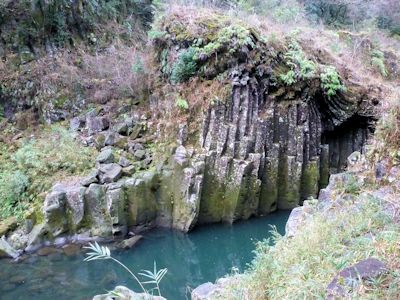
|
|
|
Aso Kusasenri Grasslands

As the symbol of Kumamoto, the country of fire, I surely know this Mt.
Aso is not one mountain.
This active volcano, in the district of Aso in the center of Kyushu Island,
is the generic term of the outer rims of the caldera and the following
5 mountains. Neko-dake, Taka-dake, Naka-dake, Kinejima-dake and Eboshi-dake.
The outer rims of the caldera are 25 km from north to south, 18 km from
east to west, and the caldera area is as wide as 380 square km.
-----
After leaving Takachiho Gorge around 14:30, we drove north-east and arrived
at Aso Kusasenri Field at 16:00, which guidebooks say is widened around
the north foot of Eboshi-dake, with the view of the volcanic smoke of Naka-dake.
In fact we could see the volcanic smoke up from Naka-dake all right, but I couldn't imagine such a pastoral scene with a large pond in the center and pastured horses. It depends on the season, and first of all, I did not enter the grasslands just taking photos on the side of a shop. There is no way for me to talk as if I knew everything.

The ropeway up to Naka-dake where you can see a huge crater of 4 km in
circumference and 150 meters in depth has been stopped by the latest eruption.
Besides, there must be various limits of sightseeing, however, I have some
will to experience the grand view of Aso.
Another visit here will perhaps be difficult for me. But if realized, I
would like to stay one night in spring or autumn and to walk around here
and there.
|
|
|
|
|
| Reading: 18' 09" |
|
|
|
|
| Part 1 Preparation, Fukuoka Airport to Beppu Spa |
| Part 2 Yufuin, Takachiho Gorge, Aso Kusasenri |
| Part 3 Yanagawa, Oura Church, Glover Garden |
| Part 4 Dazaifu Shrine, This and That |
|
|
|
|
|
|
|